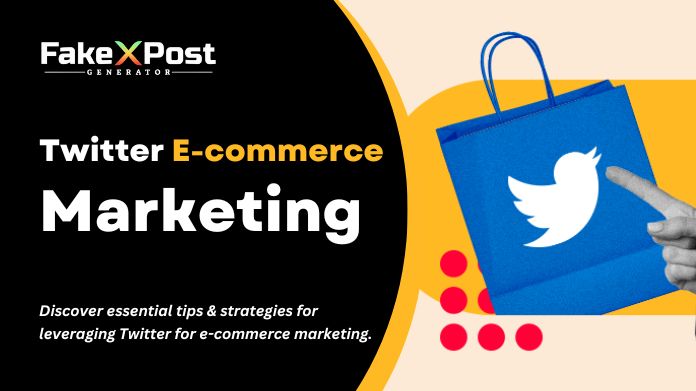In today’s digital age, social media platforms have become integral tools for businesses to connect with their audience and drive sales. Among these platforms, Twitter stands out as a powerful channel for e-commerce marketing, offering unique opportunities for brands to reach potential customers and boost their online sales.
“Twitter E-commerce Marketing: Everything You Need to Know About It” delves into the strategies, best practices, and insights businesses need to navigate and leverage the potential of Twitter for e-commerce success.
From understanding the platform’s features to implementing effective marketing campaigns, this guide provides a comprehensive overview of how businesses can harness Twitter’s reach and engagement to drive conversions and grow their online presence.
Whether you’re a small business looking to establish a presence in the e-commerce landscape or a seasoned marketer seeking to optimize your Twitter strategies, this guide will equip you with the knowledge and tools necessary to thrive in the competitive world of online retail.
Let’s explore the key aspects of Twitter e-commerce marketing and unlock the potential for your business’s growth and success.
What is Twitter E-commerce Marketing?

Twitter e-commerce marketing refers to using Twitter, a popular social media platform, as a strategic tool to promote and sell products or services online.
It involves leveraging Twitter’s features, audience reach, and engagement opportunities to drive traffic, increase brand awareness, and ultimately generate sales for businesses.
Here are some key aspects of Twitter e-commerce marketing:
1. Promotional Tweets: Businesses can use Twitter to create and share promotional tweets about their products or services. These tweets can include images, videos, links to product pages, discounts, and promotional offers to entice followers and potential customers.
2. Engagement and Interaction: Twitter provides a platform for businesses to engage with their audience directly through replies, retweets, likes, and mentions. By actively interacting with followers and responding to their queries or feedback, businesses can build relationships, establish trust, and enhance customer satisfaction.
3. Hashtags and Trends: Utilizing relevant hashtags and tapping into trending topics can help businesses increase visibility and reach a broader audience on Twitter. Incorporating popular hashtags related to products, events, or seasonal trends can boost the discoverability of e-commerce marketing campaigns.
4. Twitter Ads: Businesses can also use Twitter Ads to amplify their e-commerce marketing efforts. Twitter offers advertising options such as promoted tweets, promoted accounts, and promoted trends to target specific audiences, drive traffic to e-commerce websites, and increase conversions.
5. Influencer Collaborations: Collaborating with influencers or industry experts on Twitter can be a powerful strategy for e-commerce marketing. Influencers can help promote products or services to their followers, leveraging their credibility and influence to drive sales and brand recognition.
6. Customer Feedback and Reviews: Twitter is a platform where customers can share their experiences, feedback, and reviews about products or services. Businesses can monitor and respond to customer feedback, address concerns, and showcase positive reviews to build trust and credibility among potential customers.
Overall, Twitter’s e-commerce marketing involves a strategic approach to leverage the platform’s features, engage with the audience, leverage advertising opportunities, collaborate with influencers, and optimize content to drive sales and achieve business objectives in the online retail space.
Benefits of Twitter E-commerce Marketing

Twitter e-commerce marketing offers several benefits for businesses promoting and selling their products or services online. Here are some key advantages:
1. Broad Reach: Twitter has a vast user base with millions of active users worldwide. This allows businesses to reach a large audience and increase brand visibility.
2. Engagement Opportunities: Twitter is a platform for real-time interactions and engagement. Businesses can actively engage with their audience through tweets, replies, retweets, likes, and mentions, fostering meaningful connections and building customer relationships.
3. Targeted Advertising: Twitter offers advanced targeting options for advertising campaigns. Businesses can target their ads based on demographics, interests, behaviors, and even keywords, ensuring that their marketing messages reach the right audience most likely to be interested in their products or services.
4. Promotion of Products and Offers: Businesses can use Twitter to promote their products, services, discounts, promotions, and special offers. With visually appealing content and compelling copy, businesses can attract attention, drive traffic to their e-commerce websites, and increase sales.
5. Customer Feedback and Insights: Twitter is a platform where customers share feedback, reviews, and opinions about products and services. Businesses can gather valuable insights from customer conversations, monitor sentiment, address concerns promptly, and improve their offerings based on customer feedback.
6. Influencer Collaborations: Collaborating with influencers and industry experts on Twitter can amplify brand reach and credibility. Influencers can help promote products to their followers, leveraging their influence and trust to drive sales and brand awareness.
7. Enhanced Customer Service: Twitter can be used as a customer service tool, allowing businesses to respond to customer queries, provide support, and resolve issues quickly and publicly. This transparency can enhance customer satisfaction and loyalty.
Real-Time Marketing Opportunities: Twitter’s real-time nature enables businesses to capitalize on trending topics, events, and conversations. By staying relevant and participating in ongoing discussions, companies can increase visibility, engage with their audience, and drive traffic to their e-commerce platforms.
Twitter e-commerce marketing offers businesses a powerful platform to connect with customers, promote products, drive sales, gather insights, and enhance brand reputation in the competitive online marketplace.
Twitter Ecommerce Marketing Examples
Here are some examples of Twitter e-commerce marketing strategies that businesses have used effectively:
1. Promotional Tweets: A clothing brand tweets about a limited-time sale on its latest collection, including a link to the product page on its website. It uses engaging visuals and compelling copy to attract attention and encourage followers to purchase.
2. Twitter Ads Campaign: An electronics retailer launches a Twitter Ads campaign targeting users interested in gadgets and technology. They promote their latest smartphone model with a sponsored tweet featuring key features, customer reviews, and a “Shop Now” button that directs users to the product page for purchase.
3. Influencer Collaboration: A skincare brand partners with a beauty influencer with many Twitter followers. The influencer creates tweets showcasing their skincare routine using the brand’s products and before-and-after photos. The influencer’s endorsement and authentic content encourage their followers to try the products, driving sales for the brand.
4. Hashtag Campaign: A sports apparel company launches a hashtag campaign encouraging users to share photos of themselves wearing their products while engaging in fitness activities. They use a branded hashtag like #FitLifeStyleChallenge and offer prizes for the most creative or inspiring entries. The campaign generates user-generated content, boosts brand visibility, and encourages community engagement.
5. Flash Sales and Offers: A food delivery service tweets about a flash sale offering a discount code for a limited time. They create urgency by mentioning the limited availability of the offer and provide a clear call-to-action for users to use the discount code when ordering food online through their platform.
6. Customer Engagement: A tech company actively engages with customer queries and feedback on Twitter. They respond promptly to customer inquiries, address concerns, and provide helpful information about their products and services. This responsive customer service approach builds customer trust and loyalty, leading to repeat purchases and positive word-of-mouth.
These examples demonstrate how businesses can leverage Twitter’s features and audience reach to implement effective e-commerce marketing strategies, drive sales, and enhance brand visibility and engagement.
Conclusion
Twitter e-commerce marketing is a valuable tool for businesses to reach customers, promote products, and increase sales. Companies can connect with their audience effectively by using features like tweets, ads, and hashtags and engaging with influencers.
The benefits of Twitter marketing include reaching a large audience, getting customer feedback, and staying relevant with real-time trends. To succeed in Twitter e-commerce marketing, businesses must have a clear strategy, use analytics to track performance, and adapt based on results.
Overall, Twitter offers businesses a powerful platform to grow their online presence, engage with customers, and drive conversions, making it an essential part of modern e-commerce strategies.
